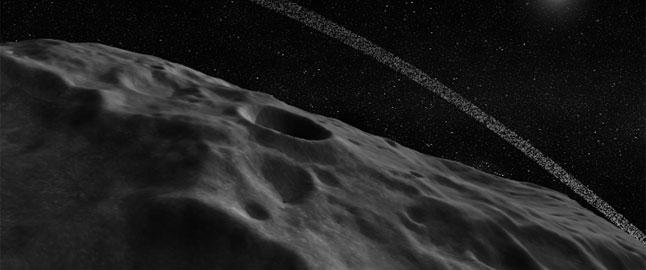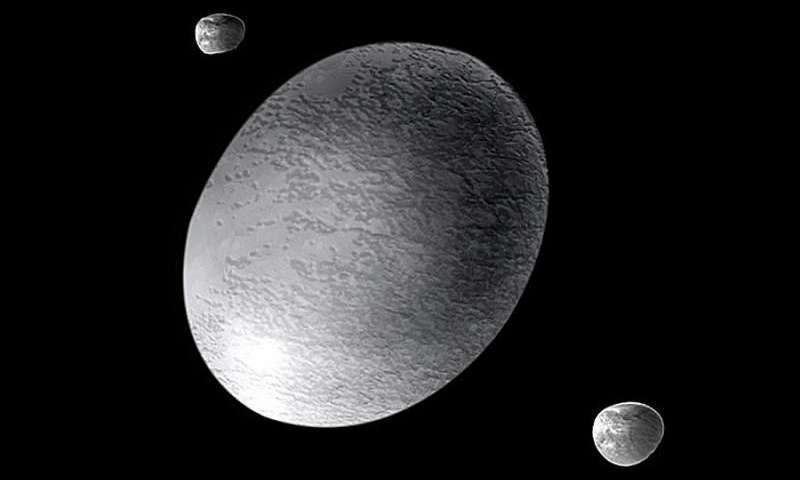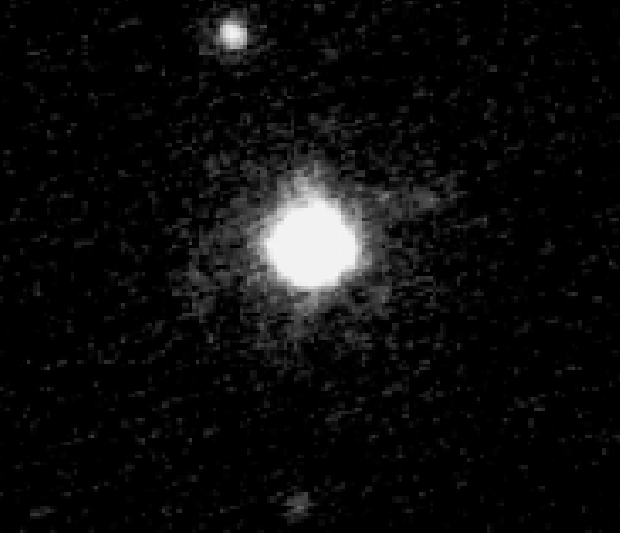
It’s not just the biggest planets in our solar system that have rings; some smaller solar system bodies are known to have rings as well, including the dwarf planet called Haumea, orbiting in the Kuiper Belt, usually farther from the sun than Pluto. In fact, Haumea is the most distant known ringed object in our solar system, so far. Astronomers discovered Haumea’s rings in 2017. The rings are so faint that we can infer their presence only when they pass in front of a more distant star, temporarily blocking the star’s light from view. So you can imagine these rings are difficult to study. Now, a new study by scientists in Brazil is providing some new insights. Othon Cabo Winter led the study, which offers clues as to how the ring formed and how it remains in a nice stable circular orbit around such a small planetary body.
The study was announced by Agência FAPESP (an electronic news agency that’s part of the São Paulo Research Foundation) on May 8, 2019. It was published February 7 in the Monthly Notices of the Royal Astronomical Society.
Findings in 2017 indicated that the orbit of the ring around Haumea was close to the 1:3 resonance region. If it were a perfect resonance, it would mean the particles in the ring make one orbit around Haumea for every three times the dwarf planet rotates. According to the new paper, Haumea’s particular orbital resonance requires a degree of eccentricity: a deviation from perfect a circularity in the rings’ orbit.
This was a puzzle since the ring appears to be very narrow and quite circular. These researchers learned there was another possible orbit – stable, circular and periodic (that is, repeating over time) – in the same region as the ring. Apparently, the ring particles move on these stable, circular, periodic orbits close to – but not within – the resonance.

In other words, according to Othon Cabo Winter, the fact that the ring is narrow and practically circular prevents action by the resonance. So the particles in the rings do not make one orbit around Haumea for every three rotations of the dwarf planet … not exactly. Winter commented:
Our study isn’t observational. We did not directly observe the ring. No one ever has.
In fact, the the ring is much too “far-flung,” he said, to be seen by observatories here on Earth. The average distance between Haumea and the sun is 43 times the distance between Earth and the sun. That’s in contrast to Pluto’s average distance of 39.5 times the Earth-sun distance. Winter continued:
Our study is entirely computational. Based on simulations using the available data on Haumea and the ring, subject to Newton’s law of gravitation, which describes the motions of the planets, we concluded that the ring isn’t in that region of space owing to the 1:3 resonance but owing to a family of stable periodic orbits.
The main aim of our research was to identify the structure of Haumea’s ring in terms of the location and size of the stable regions. We also wanted to find the reason for the ring’s existence.

Astronomers discovered Haumea in 2004. It’s classified as a trans-Neptunian object (TNO), a group of dwarf planets and other small rocky bodies that all orbit beyond the orbit of Neptune. It is so far away, it has a bone-chilling surface temperature of about -369 degrees Fahrenheit (-223 degrees Celsius). At about 905 miles (1,456 km) long, it isn’t big enough to have a nice spherical shape, so it looks more like an egg or American football. It rotates faster than any other known equilibrium body in the solar system, completing one rotation in less than four hours. It is thought to be composed mostly of rock, with a thin layer of surface ice. Haumea was officially classified as a dwarf planet in 2008, and is named after the Hawaiian goddess of fertility and childbirth.
Not long after its discovery, Haumea had another surprise for astronomers as well … two moons! Astronomers using one of the W. M. Keck Observatory telescopes on Mauna Kea in Hawaii found Haumea’s moons in 2005. The moons, Namaka and Hi’iaka, are named after Haumea’s daughters in Hawaiian mythology. Hi’iaka is the larger moon, with a diameter of about 193 miles (310 km), while Namaka is about 106 miles (170 km) across. Scientists think they formed from a collision between Haumea and another rocky body in the distant past. This collision would also account for Haumea’s fast spin rate. It might also account for the rings.
At one time, Saturn was the only body in the solar system known to have rings. And spectacular rings, at that. But since then, we’ve learned that Jupiter, Uranus and Neptune all have ring systems as well. So all the gas and ice giants in our solar system have rings, although none of the others are as dazzling as Saturn’s. Even a couple of asteroids – Chariklo and Chiron – are now known or suspected to have rings.
And, of course, Haumea has been known since 2017 to have its own system of rings. Although Haumea’s ring is very difficult to study from Earth, scientists are managing to study it. The new study from Brazil should help scientists understand how Haumea’s ring formed and what keeps it in a stable circular orbit around such a small planetary body.

Bottom line: The very remote and intriguing dwarf planet Haumea is known to have rings and moons. A new study shows how Haumea’s ring formed and maintains its nearly perfect circular shape.
Source: On the location of the ring around the dwarf planet Haumea











